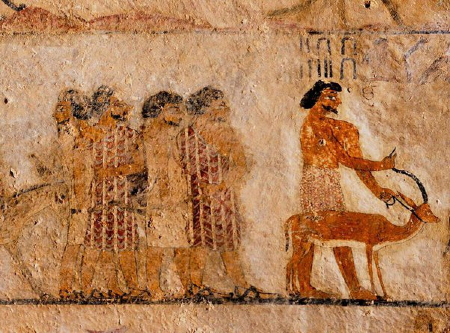We ask you, humbly: don't scroll away.
Hi readers, it seems you use Catholic Online a lot; that's great! It's a little awkward to ask, but we need your help. If you have already donated, we sincerely thank you. We're not salespeople, but we depend on donations averaging $14.76 and fewer than 1% of readers give. If you donate just $5.00, the price of your coffee, Catholic Online School could keep thriving. Thank you.Help Now >
Incense
FREE Catholic Classes
( Latin thus , Gr. thumiama ), an aromatic substance which is obtained from certain resinous trees and largely employed for purposes of religious worship. The word is also used to signify the smoke or perfume arising from incense when burned.
NATURE
In ancient times incense was furnished by two trees, viz. the Boswellia sacra of Arabia Felix, and the Boswellia papyrifera of India, both of which belong to the Terebinthian family. Mention is made of it in Num., vii, 14; Deut., xxxiii, 10, etc. It was procured from the bark much as gum is obtained at present. To enhance the fragrance and produce a thicker smoke various foreign elements were added (cf. Josephus, "Bell. Jud.", V, 5). These ingredients generally numbered four, but sometimes as many as thirteen, and the task of blending them in due proportion was assigned under the Old-Law ordinances to particular families (Cant., iii, 6).
USE
The use of incense was very common. It was employed for profane purposes as an antidote to the lassitude caused by very great heat, as perfumes are now used. Mention of its introduction into pagan worship is made by classical writers (cf. Ovid, "Metamorph.", VI, 14, Virgil, "AEneid", I, 146). Herodotus testifies to its use among the Assyrians and Babylonians, while on Egyptian monumental tablets kings are represented swinging censers. Into the Jewish ritual it entered very extensively, being used especially in connexion with the eucharistic offerings of oil, fruits, and wine, or the unbloody sacrifices ( Leviticus 6:15 ). By the command of God Moses built an altar of incense (cf. Ex.. xxx), on which the sweetest spices and gums were burned, and to a special branch of the Levitical tribe was entrusted the office of daily renewal ( 1 Chronicles 9:29 ).
When, exactly, incense was introduced into the religious services of the Church it is not easy to say. During the first four centuries there is no evidence for its use. Still, its common employment in the Temple and the references to it in the New Testament (cf. Luke 1:10 ; Revelation 8:3-5 ) would suggest an early familiarity with it in Christian worship . The earliest authentic reference to its use in the service of the Church is found in Pseudo-Dionysius ("De Hier. Ecc.", III, 2). The Liturgies of Sts. James and Mark -- which in their present form are not older than the fifth century -- refer to its use at the Sacred Mysteries. A Roman Ordo of the seventh century mentions that it was used in the procession of the bishop to the altar and on Good Friday (cf. "Ordo Romanus VIII" of St. Amand). The pilgrim Etheria saw it employed at the vigil Offices of the Sunday in Jerusalem (cf. Peregrinatio, II). Almost all Eastern liturgies bear witness to its use in the celebration of the Mass, particularly at the Offertory. In the Roman Church incensation at the Gospel of the Mass appears very early -- at the Offertory in the eleventh, and at the Introit in the twelfth century, at the Benedictus and Magnificat of the canonical Hours about the thirteenth century, and, in connexion with the Elevation and Benediction of the Blessed Sacrament, about the fourteenth century. "Ordo Romanus VI" describes the incensation of the celebrant, and in the time of Durandus (Rat. off. Div.) the assisting clergy were incensed. In the present discipline of the Western Church incense is used at solemn Mass, solemn blessings, functions, and processions, choral offices, and absolutions for the dead. On these occasions persons, places, and things such as relics of Christ and the saints, crucifix, altar, book of Gospels, coffin, remains, sepulchre, etc. are incensed. When used the incense is generally burned. There are two cases, however, when it is not consumed:
- the grains put into the Paschal candle and
- the grains put into the sepulchre of consecrated altars.
SYMBOLISM AND MANNER OF INCENSING
Incense, with its sweet-smelling perfume and high-ascending smoke, is typical of the good Christian's prayer, which, enkindled in the heart by the fire of God's love and exhaling the odour of Christ, rises up a pleasing offering in His sight (cf. Amalarius, "De eccles. officiis" in P.L., CV). Incensing is the act of imparting the odour of incense. The censer is held in the right hand at the height of the breast, and grasped by the chain near the cover; the left hand, holding the top of the chain, is placed on the breast. The censer is then raised upwards to the height of the eyes, given an outward motion and slightly ascending towards the object to be incensed, and at once brought back to the starting point. This constitutes a single swing. For a double swing the outward motion should be repeated, the second movement being more pronounced than the first. The dignity of the person or thing will determine whether the swing is to be single or double, and also whether one swing or more are to be given. The incense-boat is the vessel containing the incense for immediate use. It is so called from its shape. It is generally carried by the thurifer in the disengaged hand.
Join the Movement
When you sign up below, you don't just join an email list - you're joining an entire movement for Free world class Catholic education.
-

-
Mysteries of the Rosary
-
St. Faustina Kowalska
-
Litany of the Blessed Virgin Mary
-
Saint of the Day for Wednesday, Oct 4th, 2023
-
Popular Saints
-
St. Francis of Assisi
-
Bible
-
Female / Women Saints
-
7 Morning Prayers you need to get your day started with God
-
Litany of the Blessed Virgin Mary
Biblical Lost Alphabet Traced Back to Ancient Canaanite Civilization
-

What are the Health Benefits of Grass-Fed Beef for Your Body and Mind?
-

Rise Above Poverty is Empowering Children and Families Through Education and Compassion
-
Artists and Leaders Rally to Preserve the Traditional Latin Mass
-
Republicans Demand Answers Over Army Training Slide Labeling Pro-Life Groups as Terrorist Threats
Daily Catholic
 Daily Readings for Wednesday, July 24, 2024
Daily Readings for Wednesday, July 24, 2024 St. John Boste: Saint of the Day for Wednesday, July 24, 2024
St. John Boste: Saint of the Day for Wednesday, July 24, 2024 Prayer for Travelers: Prayer of the Day for Wednesday, July 24, 2024
Prayer for Travelers: Prayer of the Day for Wednesday, July 24, 2024- Daily Readings for Tuesday, July 23, 2024
- St. Bridget of Sweden: Saint of the Day for Tuesday, July 23, 2024
- A Child's Prayer to Mary: Prayer of the Day for Tuesday, July 23, 2024
![]()
Copyright 2024 Catholic Online. All materials contained on this site, whether written, audible or visual are the exclusive property of Catholic Online and are protected under U.S. and International copyright laws, © Copyright 2024 Catholic Online. Any unauthorized use, without prior written consent of Catholic Online is strictly forbidden and prohibited.
Catholic Online is a Project of Your Catholic Voice Foundation, a Not-for-Profit Corporation. Your Catholic Voice Foundation has been granted a recognition of tax exemption under Section 501(c)(3) of the Internal Revenue Code. Federal Tax Identification Number: 81-0596847. Your gift is tax-deductible as allowed by law.










 Daily Readings for Wednesday, July 24, 2024
Daily Readings for Wednesday, July 24, 2024 St. John Boste: Saint of the Day for Wednesday, July 24, 2024
St. John Boste: Saint of the Day for Wednesday, July 24, 2024 Prayer for Travelers: Prayer of the Day for Wednesday, July 24, 2024
Prayer for Travelers: Prayer of the Day for Wednesday, July 24, 2024

